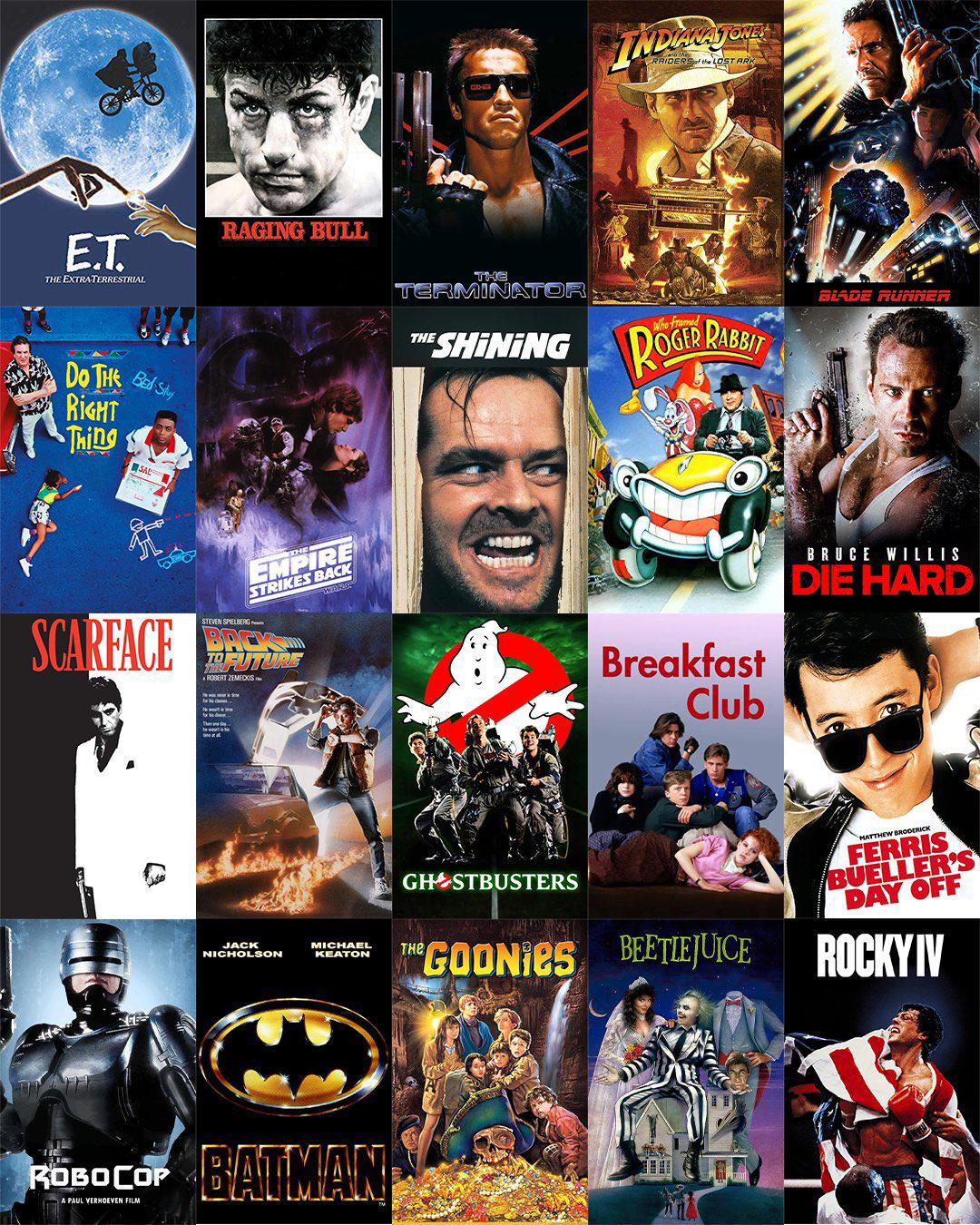9 Best Eighties Films: Must-Watch Classics from Die Hard to The Breakfast Club
The 1980s were a golden era for cinema, producing some of the most iconic and beloved films of all time. Whether you’re a fan of heart-pounding action, timeless romance, or groundbreaking sci-fi, the eighties had it all. These movies not only defined a generation but continue to influence filmmakers and captivate audiences today.
In this article, we’ll take you on a nostalgic journey through the decade’s finest cinematic gems. From unforgettable characters to epic storylines, these films have stood the test of time and remain must-watches for any movie enthusiast. Get ready to revisit the magic and excitement of the 80s with our curated list of the nine best films from that unforgettable decade.
1. Iconic Action with “Die Hard”
“Die Hard” isn’t just an action movie; it’s a cultural phenomenon that redefined the genre.
Revolutionizing Action Cinema
“Die Hard” revolutionized action cinema with its relatable protagonist, John McClane, played by Bruce Willis. Unlike previous action heroes, McClane was an everyman with vulnerabilities. The film’s intense sequences, like McClane’s daring escape from the exploding rooftop, set a new standard for action set pieces. It popularized the concept of a lone hero taking on an overwhelming enemy force, influencing countless films that followed.
Why “Die Hard” Remains A Classic
Die Hard” remains a classic because of its perfect blend of action, humor, and suspense. The film introduced one of the most memorable villains in cinema, Hans Gruber, played by Alan Rickman. Iconic lines like “Yippee-ki-yay, motherf***er!” have entered pop culture lexicon. The Christmas Eve setting added a unique twist to the typical action film, making it a go-to movie for both action and holiday film enthusiasts.
2. Adventure Reimagined in “Indiana Jones: Raiders of the Lost Ark”
The Impact on Adventure Genre
“Indiana Jones: Raiders of the Lost Ark” redefined adventure films. It took the classical elements of exploration, treasure hunting, and danger, and created a timeless formula. Directed by Steven Spielberg and produced by George Lucas, this film set a new standard for the genre. It combined thrilling action scenes with historical lore and exotic locations, inspiring countless adventure movies that followed. By juxtaposing traditional heroism with relatable flaws, the film gave audiences a compelling and immersive experience.
Iconic Moments and Characters
The boulder chase scene remains one of the most memorable in film history. When Indiana narrowly escapes a giant rolling boulder, you feel the tension and excitement. Another iconic moment is the face-off with the sword-wielding enemy, where Indy casually opts for his gun—an unexpected yet humorously satisfying resolution. Characters like Marion Ravenwood, with her fierce independence, and Sallah, the trustworthy ally, enrich the storyline. Each adds depth and complexity, making the cast as memorable as the action sequences.
3. Teen Angst in “The Breakfast Club”
Exploring Teen Issues in the 80s
Discover how “The Breakfast Club” delves into the emotional complexities of adolescence. Directed by John Hughes, the film captures the struggles of five high school students from different cliques. Characters like Claire, the popular girl, and Bender, the rebel grapple with expectations, identity crises, and peer pressure. This iconic movie portrays teen issues, from family conflict to academic pressure, making it relatable even today.
Cultural Significance and Legacy
Understand the impact “The Breakfast Club” had on pop culture. Its portrayal of high school life and the nuanced performance of its cast turned it into a cultural phenomenon. The film’s memorable quotes and themes continue to influence modern teen dramas. Additionally, it introduced “Don’t You (Forget About Me)” by Simple Minds, embedding the film in the collective memory of the 80s.
4. Sci-Fi Innovation with “Blade Runner”
“Blade Runner” is a cornerstone of sci-fi cinema, pioneering visual and narrative techniques that have influenced countless works.
Visual and Narrative Innovations
Explore. “Blade Runner” excels in its visionary aesthetic, combining neon-drenched cityscapes with futuristic technology. Director Ridley Scott used groundbreaking special effects, detailed miniatures, and atmospheric lighting to create a visually stunning dystopian world that still captivates audiences today. The intricate set designs and innovative use of Vangelis’s haunting score set an immersive tone that has been emulated by many subsequent sci-fi films.
The Enduring Themes of Human Identity
Analyze. “Blade Runner” delves into profound questions about what it means to be human. The movie’s replicants, especially Roy Batty, challenge your understanding of life, consciousness, and morality. The storyline questions the nature of identity, empathy, and the boundaries between human and machine. These enduring themes give “Blade Runner” its lasting relevance, as it prompts you to reflect on humanity’s future in a world increasingly defined by artificial intelligence and genetic engineering.
5. Cultural Phenomenon of “E.T. the Extra-Terrestrial”
Steven Spielberg’s “E.T. the Extra-Terrestrial” became an immediate cultural phenomenon upon its release in 1982. The film captivated audiences with its heartfelt story and groundbreaking visuals.
Emotional Storytelling and Special Effects
Spielberg’s storytelling created a profound emotional connection between audiences and the characters. The bond between young Elliot and the alien E.T. is touching and sincere. Special effects in “E.T.” achieved groundbreaking realism. E.T.’s lifelike movements and expressions were revolutionary, thanks to animatronics and practical effects. This seamless integration brought an extraterrestrial creature to life in an endearing, believable way, making audiences care deeply about E.T.’s fate.
How “E.T.” Captured Hearts Globally
“E.T.” resonated with viewers across the world, breaking box office records and becoming the highest-grossing film of the 1980s. Its universal themes of friendship, family, and acceptance attracted a diverse audience. The iconic image of E.T. and Elliot’s bike ride across the moon became a symbol of adventure and wonder. “E.T.” received nine Academy Award nominations, winning four, further cementing its status as a beloved classic. The film’s enduring popularity demonstrates its powerful impact on global culture.
6. Fantasy and Magic in “The Princess Bride”
Rob Reiner’s 1987 film, “The Princess Bride,” merges fantasy and magic, creating a timeless classic. This enchanting tale captivates audiences with its humor, adventure, and unforgettable characters.
Combining Humor and Adventure Flawlessly
Rob Reiner blends humor and adventure seamlessly in “The Princess Bride”. You’ll discover both thrilling sword fights and laugh-out-loud moments. Characters like Inigo Montoya and Vizzini deliver witty lines while engaging in high-stakes quests. This perfect mix lets you enjoy a story that never takes itself too seriously yet remains deeply engaging.
Memorable Quotes and Scenes
“The Princess Bride” boasts an array of memorable quotes and scenes. You’ll likely recall the iconic line: “Hello, my name is Inigo Montoya. You killed my father. Prepare to die.” Scenes like the Fire Swamp and the Battle of Wits with Vizzini are equally unforgettable. These elements ensure the film remains etched in your memory long after the credits roll.
7. Epic Storytelling in “Back to the Future”
“Back to the Future” stands as one of the great cinematic triumphs of the 1980s, blending adventure, humor, and a touch of sci-fi magic.
Time Travel and Its Influences on Pop Culture
The film popularized time travel in mainstream media like no other. Released in 1985, it sparked interest in the concept, leading to numerous films, TV shows, and books that explored time travel (e.g., “Doctor Who,” “Bill & Ted’s Excellent Adventure”). Its DeLorean time machine became an iconic pop culture symbol, often referenced in other works. By seamlessly weaving together elements of past, present, and future, the film set a benchmark for effective storytelling in sci-fi.
Unforgettable Character Dynamics
You can’t discuss “Back to the Future” without mentioning its unforgettable characters. Marty McFly (Michael J. Fox) and Doc Brown (Christopher Lloyd) share a dynamic that’s both heartwarming and hilarious. Their friendship, filled with memorable exchanges and innovative gadgets, drives the narrative. Additionally, the film features an intriguing look at family relationships, especially through the lens of time, creating a unique and relatable experience for viewers.
8. Horror Redefined by “The Shining”
Stanley Kubrick’s “The Shining” transformed the horror landscape in the 1980s with its chilling narrative and unforgettable imagery.
Psychological Depth and Cinematic Techniques
Kubrick employed psychological horror to grip audiences. The film delves into Jack Torrance’s descent into madness, using isolation at the Overlook Hotel as a catalyst. Kubrick’s meticulous framing and the haunting score create an eerie atmosphere. He used long takes and wide-angle shots to enhance the feeling of unease, making every scene visually captivating.
How “The Shining” Reshaped the Horror Genre
“The Shining” broke away from traditional horror tropes. It focused on atmosphere and tension rather than jump scares. Kubrick’s adaptation of Stephen King’s novel brought a new level of sophistication to horror films. The film’s impact is profound, influencing countless directors and solidifying its status as a cornerstone of psychological horror.
9. The Dance Craze of “Flashdance”
1983 saw “Flashdance” spark a global dance craze. This musical drama introduced unique choreography and unforgettable scenes.
“Flashdance” and Its Impact on Music and Fashion
“Flashdance” revolutionized music and fashion in the ’80s. The soundtrack, featuring Irene Cara’s hit “Flashdance… What a Feeling,” topped charts worldwide. Leg warmers, ripped sweatshirts, and off-the-shoulder tops became fashion staples, immortalizing the film’s style. The movie’s aesthetic influenced everything from music videos to streetwear, defining an era.
Symbolizing the Spirit of the Eighties
“Flashdance” encapsulated the spirit of the ’80s with its blend of ambition and passion. The storyline of Alex Owens, a welder by day and dancer by night, resonated with audiences chasing dreams against the odds. The film’s energetic dance sequences and empowering narrative highlighted the decade’s cultural ethos, driving home the message that with determination and hard work, anything is possible.
Conclusion: Revisiting the Classics
The 1980s gave us a treasure trove of films that continue to inspire and entertain. Each movie from this era brought something unique to the table, whether it was groundbreaking storytelling, unforgettable characters, or iconic fashion and music trends. These films didn’t just entertain; they shaped cultural conversations and left an indelible mark on cinema history.
Revisiting these classics allows you to appreciate the creativity and passion that defined the ’80s. Whether you’re a longtime fan or discovering these gems for the first time, these films offer a nostalgic journey back to a vibrant and influential decade. So grab some popcorn, sit back, and enjoy the magic of ’80s cinema.






